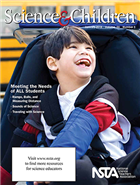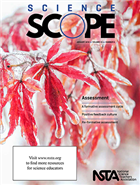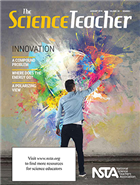Ideas and inspiration from NSTA’s January 2018 K-12 journals
By Mary Bigelow
Posted on 2018-01-10
Installing Glass Walls and Doors in the Science Classroom, a commentary in Science Scope, describes what collaborative teacher teams “look like” in science and is appropriate for teachers at all grade levels to begin or fine-tune the process with a sample agenda, frameworks, and ideas for team-building and reflection.
February is the month for the annual Great Backyard Bird Count. Find out how you and your students can get involved in Citizen Science: Birds, Binoculars, and Biodiversity, The data are available to students and are used in ongoing research projects.
 Science & Children – Meeting the Needs of ALL Students
Science & Children – Meeting the Needs of ALL Students
Editor’s Note: Removing Barriers: “Science is for ALL. Not just students who are highly capable physically and mentally. Meeting the needs of the entire population is what we do. Remove as many barriers as possible, make learning accessible, and support students as they find their strengths to build on… The purpose of the modifications is not to change what they [students with physical disabilities] conceptually learn, it is to support them in learning.”
The lessons described in the articles have a chart showing connections with the NGSS and many include classroom materials and illustrations of student work.
- Traveling with Science Illustrates how to design activities related to forces for students with visual impairments.
- Students investigate the properties Marvelous Metals Matter! and integrate engineering design principles in this multidisciplinary 5E lesson.
- Bringing Back Our Bayou Chico describes how to use the Universal Designfor Learning (UDL) framework for activities that simulate watersheds and involve all students in meaningful learning.
- The 5E lesson in Sounds of Science demonstrates how students with a hearing loss can learn about the properties of sound waves (“with instructional benefit for all students inthe classroom and not just those deaf or hard of hearing.”)
- Ramps, Balls, and Measuring Distance—For All exemplifies how, with advanced planning and accommodations, the needs of students with disabilities can often be met “in a manner that emphasizes inclusion and independence.”
- The Early Years: An Activity for Every Child includes a seed-planting activity that allows all children to actively participate and document their understanding of seeds.
- Teaching Through Trade Books: Energy Explorations has two lessons and related trade books on the topic of the sun as a source of energy.
- Children can be engineers. Engineering Encounters: Identifying an Engineering Design Problem integrates cooking with the design process. Student engineer a recipe for pancakes.
- The project described in Teaching Teachers: The Scientist Showcase could be adapted for classrooms and younger students to explore the contributions of scientists from underrepresented backgrounds.
- Methods and Strategies: Teaching the Nature of Science to Elementary Students describes how, with appropriate scaffolding, elementary students can understand what science is and what scientists do.
These monthly columns continue to provide background knowledge and classroom ideas:
- Science 101: Why Do Computers Keep Getting Smaller and Smaller?
- Science 102: A Bunny of a Different Color
- Formative Assessment Probes: Uncovering Representations of the Water Cycle
- The Poetry of Science: Seeing Clearly
For more on the content that provides a context for projects and strategies described in this issue, see the SciLinks topics Alternative Energy Sources, Erosion, Forces and Motion, Heat and Temperature, Matter, Metals/Nonmetals, Nature of Science, Renewable and Nonrenewable Energy, Scientists, Seed Germination, Sound, Sun, Water Cycle, Watersheds, Ways to Measure

Science Scope – Assessment
From the Editor’s Desk: Engaging Students in Learning Through Assessment==
“The Next Generation Science Standards requires us to rethink and retool our assessments so that they reflect the shift to three-dimensional teaching and learning…Such assessments represent an opportunity to learn about our own teaching while engaging students in meaningful work.”
Articles in this issue that describe lessons include a helpful sidebar (“At a Glance”) documenting the big idea, essential pre-knowledge, time, and cost; many follow a 5E format. The lessons also include connections with the NGSS, and many include examples of student work, assessments, and classroom materials.
- The author of Re-Formative Assessment: One Teacher’s Approach to Integrating Science Within Science to Reassess Student Understanding describes a process she uses to assess students’ enduring understanding and identify misconceptions. Examples of student responses to open-ended prompts are included.
- Creating a Positive Feedback Culture: Eight Practical Principles to Improve Students’ Learning provides examples of feedback that goes beyond “good job” or a letter grade (e.g., prompts and discussion-starters).
- Wilderness Water Crisis: Next Generation Science Standards–Aligned Assessments for an Energy Activity integrates three-dimensional assessment and problem-solving into an engaging, authentic activity.
- Teachers’s Toolkit: The Four Elements of the Claim, Evidence, Reasoning, and Rebuttal (CERR) Framework
- Not all assessments require paper and pencil. This month’s Listserv Roundup: Technology tools for paperless formative assessment has suggestions from our colleagues on alternatives.
- Change your classroom interactions from Q and As to “accountable talk” as formative assessment with the strategies in Science for All: Encouraging Academic Talk
- Teacher to Teacher: The Steps of a Conceptual Storyline describes how students can construct scientific explanations or design solutions, demonstrating their proficiency.
These monthly columns continue to provide background knowledge and classroom ideas:
- Scope on the Skies: Timely Motions of the Earth and Moon
- Disequilibrium: Why Is Regular Soda Denser Than Diet Soda?
- Integrating Technology: Bringing Science to Life (Using social learning to make real-world connections in science).
For more on the content that provides a context for projects and strategies described in this issue, see the SciLinks topics Asteroids, Bird Adaptations, Bird Characteristics, Density, Earth-Moon Connection, Energy TranMoon, States of Matter, Thermal Energy, Water Cycle
 The Science Teacher – Innovation
The Science Teacher – Innovation
Editor’s Corner: New Year, New Look “Remember that NSTA members can access all TST articles from 2000 to the present online at nsta.org. TST is also now available in a digital version for computer, Kindle Fire, Android tablet/phone, and Apple devices at http://bit.ly/digital-journals“
The lessons described in the articles include connections with the NGSS and many include classroom resources and illustrations of student work.
- Where Does the Energy Go? has a new version of a lesson in which students explore energy and motion of a bouncing ball and share their thoughts with Claims-Evidence-Reasoning statements..
- The 5E lesson in A Compound Problem uses modeling to understand the effects of the depletion of the ozone layer.
- Use a microscope in teaching geology and physics? Take A Polarizing View into this innovative use with a 5E lesson.
- Innovations do not necessarily lead to brand-new inventions. The author of Build an Interactive Word Wall illustrates how to take a traditional tool and re-invent it for today’s students to use interactively.
- Looking for funding for your classroom innovations? Where the Money Is guides you through the process of applying for grants.
- Students may be fascinated by the idea that we “continually recycle atoms and molecules that were previously part of every person who has ever lived.
- Focus on Physics: Our Molecular Selves
These monthly columns continue to provide background knowledge and classroom ideas:
- Right to the Source: Invention vs. Innovation
- Career of the Month: Robotics Engineer
- The Green Room: The Top 5 Environmental Stories of 2017
For more on the content that provides a context for projects and strategies described in this issue, see the SciLinks topics Energy Transformations, Igneous Rock, Inventors, Law of Conservation of Energy, Law of Conservation of Matter, Metamorphic Rock, Microscopes, Ozone Depletion, Robots, Rock Cycle, Sedimentary Rock, Thomas Edison, Types of Rocks, Ultraviolet Light
Installing Glass Walls and Doors in the Science Classroom, a commentary in Science Scope, describes what collaborative teacher teams “look like” in science and is appropriate for teachers at all grade levels to begin or fine-tune the process with a sample agenda, frameworks, and ideas for team-building and reflection.
From feet to color to teeth, animals have many special structures that help them survive. These physical characteristics help them move, find food, and protect themselves. Animal Adaptations allows children to use their powers of observation to compare the physical characteristics of animals in figure out how the characteristics help the animals survive in their environments. Children also explore how changes to an environment affect the ability of animals to survive. Animal Adaptations is based on the interactive e-book, I Live Where I Live Because.
From feet to color to teeth, animals have many special structures that help them survive. These physical characteristics help them move, find food, and protect themselves. Animal Adaptations allows children to use their powers of observation to compare the physical characteristics of animals in figure out how the characteristics help the animals survive in their environments. Children also explore how changes to an environment affect the ability of animals to survive. Animal Adaptations is based on the interactive e-book, I Live Where I Live Because.

